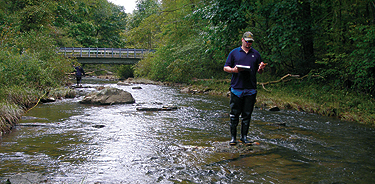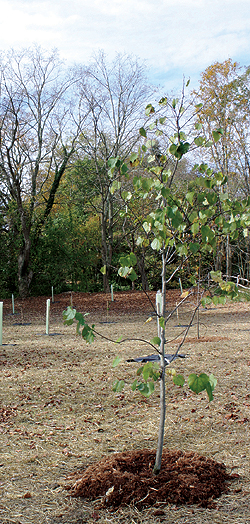Conservation Program Focuses on Proactive Watershed Protection

The Conservancy’s watershed staff provides technical assistance, develops river conservation plans and restores streams across the region.
Near the headwaters of Loyalhanna Creek in Westmoreland County, the stream gently curves around a wooded bend near a private property. The quietly moving stream, with its runs, riffles and pools, is home to trout and macroinvertebrates like dragonflies, snails and mayflies. Root systems from old trees, called rootwads, stabilize the stream bank.
Natural and native logs, rocks and other material in the stream and the vegetation growing along the waterway disguise the fact that this stretch of Loyalhanna Creek was the focus of a restoration project about a year and a half ago. The Western Pennsylvania Conservancy worked with the Pennsylvania Fish and Boat Commission and the Loyalhanna Watershed Association to design the improvements, secure the funding, communicate with residents, coordinate the work and implement the changes.
The Conservancy not only stewards its own properties and privately-owned properties under conservation easement, but also works to protect and restore streams, creeks, rivers and watersheds throughout the region. Sometimes the stewardship of these natural resources requires efforts beyond protection from future development or disturbance. It may also involve proactive efforts to correct past damage or minimize future degradation.

WPC’s Watershed Conservation Program has protected 16,000 feet of stream and creek by planting trees and shrubs in riparian zones.
For nearly 13 years, WPC’s watershed conservation program has worked with watershed groups, like-minded organizations, landowners and businesses to help them manage properties in ways that reduce environmental impact and improve water quality. The Conservancy staff members provide technical assistance, perform watershed assessments, install restoration projects and develop river conservation plans.
The program orchestrates designers, contractors and other elements for in-stream construction projects, such as stream habitat design and stream bank stabilization.
In the first three quarters of 2013, the watershed conservation program was responsible for building over 250 in-stream habitat structures, involving elements such as rootwads and the log vanes. The program was also responsible for stabilizing over 11,000 feet of stream bank.
Before June 2012, the now-restored section of the 298-square-mile Loyalhanna Creek watershed near Rector, Pa., was prone to flooding. Years of mowing and vegetation removal along the sides of the stream caused banks to erode and sedimentation to wash into the creek. The stream slowly ate away at the banks, and trees were leaning in toward the creek when the Conservancy’s work began.
Almost immediately, the stream improved, said WPC watershed scientist Greg Schaetzle. Thanks to the native materials used to improve the habitat and the corresponding increase in food supply, trout have begun naturally breeding there, Schaetzle said.
“Human interaction usually causes most of the problems that we see. Mowing to the edge of the stream bank, cows grazing near and walking in the stream and other common mistakes can cause problems to the entire stream,” Schaetzle said. “But we’re figuring out the best ways to fix these problems – everything from stream bank stabilization ideas, to planting trees, to adding woody debris to waterways to attract macroinvertebrates and trout.”
Healthy moving bodies of water such as rivers and streams contain riffles, runs and pools that provide a variety of habitats for vegetation and animals. Healthy, stable streams also contain a diverse community of macroinvertebrates, an important component of the aquatic food chain.
Macroinvertebrates need specific environmental conditions, such as appropriate pH, temperature and oxygen levels, in order to survive. A number of factors, including loss of stream bank vegetation, sedimentation or pollution, can affect water quality.
In addition to in-stream work, the watershed conservation program also helps farmers install fencing that keep livestock out of streams and creates centralized cattle crossings for streams. Also in 2013, WPC protected another 16,000 feet of stream and creek by planting trees and woody shrubs in riparian zones.
“A healthy riparian zone – or land adjacent to waterways – has a forested ecosystem that provides shade, habitat and a sediment buffer,” said Jenifer Christman, associate vice president of the Conservancy’s Watershed Conservation Program. “We’re happy to provide this kind of science-backed stewardship to the region’s natural resources.”
Visitors can hike on an abandoned railroad bed paralleling Penns Creek. The railroad grade is at treetop level, which affords good views of warblers and other migrating birds. The railroad bed is an easy walk, allowing attention to focus on wildlife. The trail eventually leads to an abandoned tunnel and bridge that crosses Penns Creek with access to Poe Paddy State Park.
In a few months, spring migrating songbirds will use Penns Creek as a travel corridor.
The Conservancy first became interested in the Cherry Run land in 1971 and negotiated for eight years with the B & R Lumber Company of Johnstown. During this time, the Pennsylvania Game Commission made a commitment to acquire the land and agreed to reimburse the Conservancy for the land over a period of years.
To finance the project, WPC negotiated a long-term loan with Mellon Bank of Pittsburgh. This marked the first time that the Conservancy had to borrow funds for a land project, but the loan allowed WPC to keep its revolving land acquisition fund intact and available for other projects already under negotiation.
But this large tract of mountain wilderness is not the only WPC land conservation project in the Central Valleys and Ridges.
Last year, WPC permanently conserved a major expanse of mountainside forest over a key tributary to the Potomac River. Hardwood Trails is composed of more than 1,600 acres on Evitts Mountain in Bedford County.
The acquisition helps to protect Evitts Creek and the lakes formed by the creek, Lake Koon and Lake Gordon, which are just below the property. The hillsides above them are important to protect, both for their own conservation values and for the benefit of the lakes’ water quality, partly because the lakes supply drinking water for the city of Cumberland, Md.
“This is a key conservation property, a huge mountainside parcel in Bedford County,” said Thomas D. Saunders, president and chief executive officer of the Conservancy. “It creates one large linkage of protected lands from Rocky Gap State Park in Maryland up into Pennsylvania’s Buchanan State Forest.”
WPC will transfer the Hardwood Trails property to the state’s Department of Conservation and Natural Resources’ (DCNR) Bureau of Forestry to become a new addition to Pennsylvania’s Buchanan State Forest.
The Conservancy has protected more than 250 acres around Sideling Hill Creek, which flows through the southern reaches of Bedford and Fulton counties and is home to important ecosystem features such as shale barrens, rare freshwater mussel species and a freshwater sponge.
What is a Watershed?
It’s a term the Conservancy throws around often and we all live in one: a watershed...
<read more
